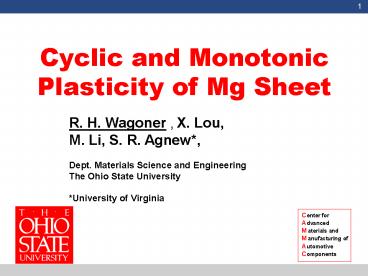Cyclic and Monotonic Plasticity of Mg Sheet
Title:
Cyclic and Monotonic Plasticity of Mg Sheet
Description:
Cyclic and Monotonic Plasticity of Mg Sheet R. H. Wagoner , X. Lou, M. Li, S. R. Agnew*, Dept. Materials Science and Engineering The Ohio State University –
Number of Views:124
Avg rating:3.0/5.0
Title: Cyclic and Monotonic Plasticity of Mg Sheet
1
Cyclic and Monotonic Plasticity of Mg Sheet
R. H. Wagoner , X. Lou, M. Li, S. R. Agnew,
Dept. Materials Science and Engineering The
Ohio State University University of Virginia
2
Acknowledgements
3
- Introduction
4
Mg Sheet for Forming Applications
Advantages Low density - High strength- High
stiffness
Challenges Room-temp. formability - Asymmetric
flow behavior
Opportunity Forming operation using asymmetric
flow?
5
Slip Deformation in Mg
ltagt No strain parallel to basal poles
Pyramidal
Pyramidal
ltcagt Difficult to activate
Prismatic
Basal 0001
6
Tensile Twinning in Mg
Tension
ST
TD
RD
original c
Compression
Matrix
Tension
Patridge, Metall. Reviews,1967
7
- Experiments
8
Tension / Compression Test
Boger et al., Int. J. Plasticity, 2005
9
Simple Shear Test
Gracio et al. Adv. Mat. Forum, 2002
10
Acoustic Emission
Burst AE (ms) Continuous AE (ms)
- Outputs
- Cumulative Count
- Time Count Rate
- Strain Count Rate
Threshold
One AE Burst Event
11
- Results
12
Monotonic Tension, Fracture
Mg AZ31B Al 6013
13
Monotonic Tension vs. Compression
14
Evolution of R-Values
15
Single-Cycle Tests C-T-C vs. T-C-T
16
Single-Cycle Tests C-T-C vs. T-C-T
17
Multiple Cycle Tests
a) Small strain, 0.04 b)
Large strain, 0.07
18
Saturation with Cycling
a) Small strain, 0.04 b)
Large strain, 0.07
19
Microstructure Evolution
20
Evolution of Twinning vs. Slip
6.4 max. twin strain (single xl) 5.9 max. twin
strain (basal texture)
21
Texture Evolution
(a) Initial
(b) 0.10 RD tensile strain
22
Texture Evolution
(c) 0.07 RD compressive strain
(d) 0.1 reverse tensile strain
23
Accoustic Emission, T-C
24
Accoustic Emission, C-T
25
Acoustic Emission, T-C-T
26
Acoustic Emission, C-T-C
27
Discussion
28
Deformation Mechanism Summary
Tension
- Slip dominated
- Twinning Slip (inflected)
Compression
Reverse Tension
- Detwinning Slip (inflected)
29
Roles of Twins on Hardness
- CRSS stwinning- suntwinning st/u
- Obstacles to slip ?sobstacle
- Reorientation of texture, ?stexture sw/twins -
sw/o twins
? Can these roles be estimated quantitatively?
30
Saturated Cycle Segments C, T
31
Adjusted Stress-Strain Comparison
32
Twinning Effect on Hardness
States 0.01 T 58 twinned, deformation
by untwinning and slip 0.01 C 17
twinned, deformation by twinning and slip
0.05 T 17 twinned, deformation by untwinning
and slip 0.05 C 58 twinned, deformation
by twinning and slip
Equations
Solution
? Obstacle effect of twinning is 1/3-1/4 that of
texture or CRSS
Lebensohn Tome Acta Metall, 1993
33
Twinning Effect on Hardness - corrected
States 0.01 T 58 twinned, deformation
by untwinning and slip 0.01 C 17
twinned, deformation by twinning and slip
0.05 T 17 twinned, deformation by untwinning
and slip 0.05 C 58 twinned, deformation
by twinning and slip
Equations
Solution
? Obstacle effect of twinning is 1/3-1/4 that of
texture or CRSS
Lebensohn Tome Acta Metall, 1993
34
Conclusions
- Burst AE is correlated with twin nucleation, not
growth - Strain from twinning in compression initially
90, dropping to 50 at a strain of -0.05. - AE shows a second range of intense twin
nucleation at strains of -0.06, near the
exhaustion of twinning. - Brittle fracture occurs in tension and simple
shear. - The relative effects of twinning on flow stress
have been estimated the obstacle effect is
1/4-1/3 that of the texture effect or CRSS.
35
Conclusions - corrected
- Burst AE is correlated with twin nucleation, not
growth - Strain from twinning in compression initially
90, dropping to 50 at a strain of -0.05. - AE shows a second range of intense twin
nucleation at strains of -0.06, near the
exhaustion of twinning. - Brittle fracture occurs in tension and simple
shear. - The relative effects of twinning on flow stress
have been estimated the activation stress for
twinning vs. untwinning is double that of the
obstacle effect or the texture effect.































